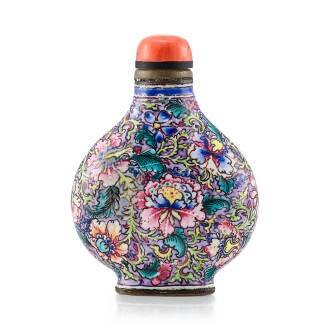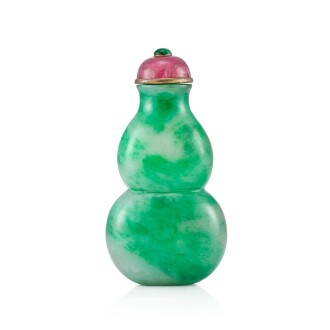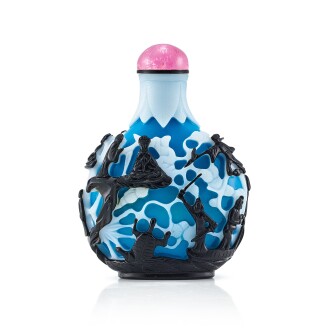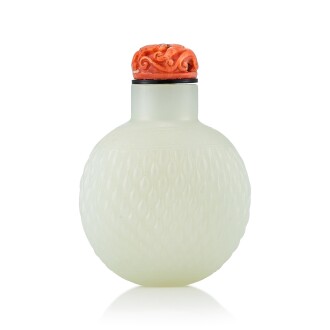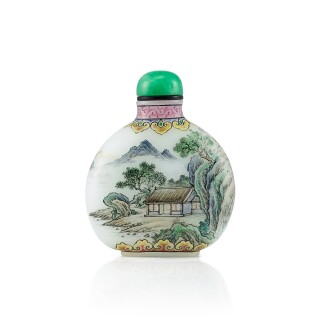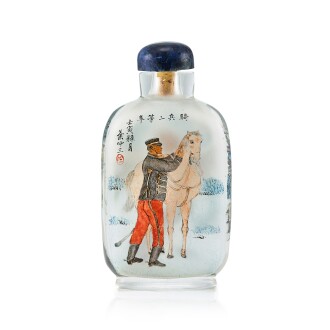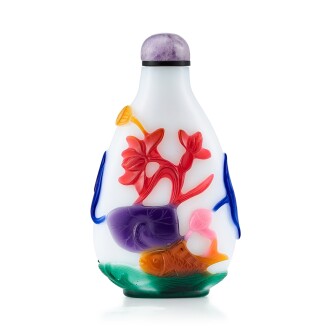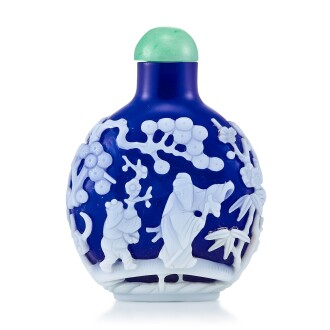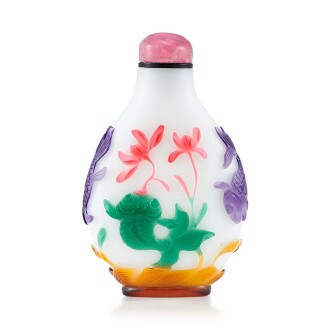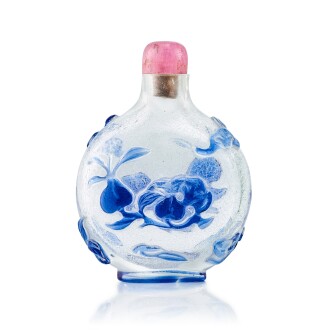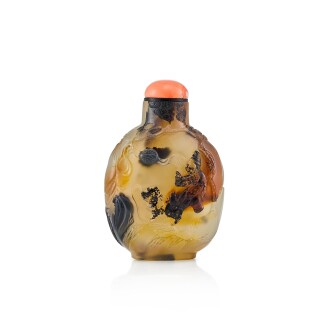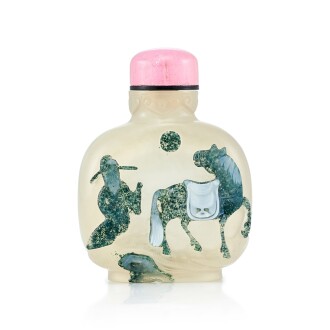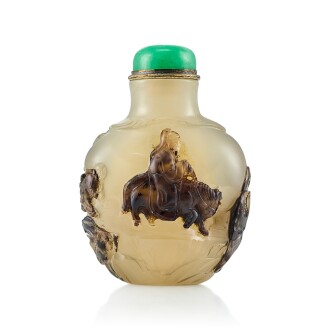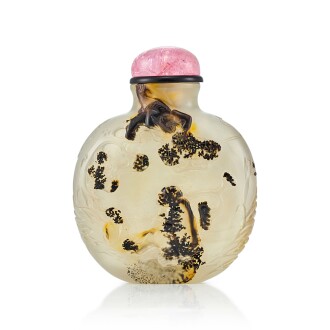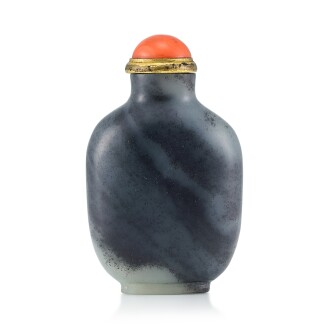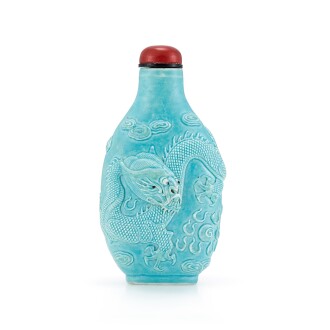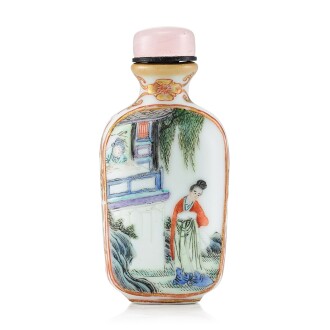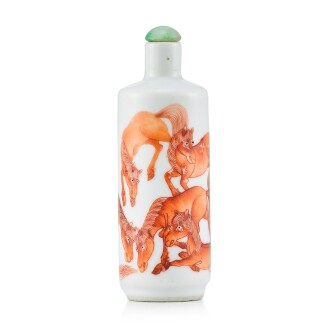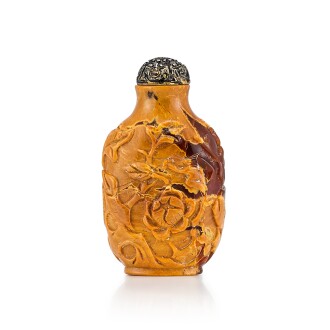Snuff bottles are microcosms of Chinese works of art. The finest collections are more than a sum of its miniature parts – together telling the story of the wealth and power of the last imperial dynasty of China. Snuff Bottles from a German Private Collection (5–10 February, Hong Kong) presents a fine collection of snuff bottles, assembled by an erudite German collector from the late 1970s to 1990s. Primarily under the guidance of the Hong Kong snuff bottle connoisseur and dealer C.K. Liang, but also from Sotheby’s auctions, the collector was able to acquire the finest examples available on the market.
鼻煙壺可謂中國藝術的微觀世界。在這些精緻小巧的珍藏之中,可以窺見中國最後一個皇朝的盛世風華。德國私人珍藏鼻煙壺網上專場拍賣會(2月5日至10日,香港)欣呈多件華麗精美的鼻煙壺珍品,整個收藏由一位博學多聞的德國藏家在1970至1990年代悉心集成。在香港鼻煙壺鑑賞家及古董商梁宗亢的悉心指導下,藏家在蘇富比拍賣會上尋寶覓珍,得以將市面上的優秀作例什襲而藏。
Featured Highlights 點睛之作
The artistry and range of materials used in the creation of this array encapsulates the kaleidoscopic diversity of Qing dynasty court art. A brilliantly enamelled Qianlong period European-subject bottle showcases a motif favoured by the Emperor, a rare Yongzheng reign-marked snuff bottle is delightful with its spontaneous detailing of various flora and fauna, and another snuff bottle bearing a Jiaqing reign mark depicts a “Ruby Landscape” exquisitely rendered in puce enamel. The collection is also particularly strong in carved agate and jade bottles, with an additional focus on multi-coloured overlay glass.
本收藏的鼻煙壺作例用料繁多、工藝精湛,體現清代宮廷藝術多姿多彩的風貌。一件乾隆年製畫琺瑯西洋人物圖鼻煙壺設計精美,呈現皇上最喜愛的紋飾主題;一件罕有畫琺瑯百花圖鼻煙壺(《雍正年製》款)巧飾花鳥動物圖案,細節繁複;另一件畫琺瑯胭脂紅山水人圖鼻煙壺(《嘉慶年製》款)施胭脂紅釉,雍容優雅。收藏另聚焦刻面瑪瑙及玉製鼻煙壺,彩色套料作例亦是焦點所在。


Antique enamelled snuff bottles show the broad range of Qing dynasty works of art in miniature. The application of the enamel on porcelain, glass or other materials require technical virtuosity and skilled workmanship. The imperial snuff bottles highlighted above offer a glimpse into the aesthetic preferences of different Qing emperors and the high level of skill and artistry during those periods. Another notable example in the collection is the work of the artist Wang Xisan, who was taught the art of enamelling by Ye Bengqi and who used a distinctive technique of enamelling. Wang did not produce a large number of enamel snuff bottles, and in the collection there is a rare example enamelled with a landscape.
施釉上彩的鼻煙壺,極能展現清代藝術品的多樣姿采。為瓷器、玻璃或其他物料施釉上彩,特別考驗工匠的造詣。這些御製鼻煙壺不僅反映歷任清代皇帝的不同品味,亦體現當時中國藝術品的精湛工藝與製作技術。本收藏的另一焦點為工藝美術大師王習三的匠心傑作,王習三隨葉菶祺修習琺瑯工藝,其後創出獨一無二的內畫技法。他的畫琺瑯鼻煙壺作品為數甚少,可見本收藏的畫琺瑯山水圖作例乃十分珍貴。

These snuff bottles are typically made of crystal or glass, and the interior surface of the bottle served as the canvas for the minuscule painting. Painting from the inside of the snuff bottle would require the highest level of skill, as the artists would apply the decoration using a narrow brush of one or two bristles. These works are a technical wonder. The collection includes rare examples in agate and amber.
此類鼻煙壺主要為水晶或玻璃製,內側畫細繪紋飾。畫師以一纖細畫筆刻劃內畫,巧奪天工,極為可觀。

This collection is notable for the sheer quality of glass bottles. Glass is the most popular type of material owing to its versatility; it has wide range of colour and can imitate the properties of jade, crystal, stone, and amber. Glass snuff bottles feature overlay glass technique, in which layered glass of different colours are carved in low relief.
本收藏以料胎鼻煙壺最為卓越。玻璃用途多變,是最常見的鼻煙壺製作材料,其顏色多樣,可模仿玉石、水晶及琥珀等石材的特質。套料鼻煙壺的工序為先取地色料,再覆蓋上層色料,然後精工雕刻而成。

The collection is also particularly strong in carved agate. This type of stone was favoured in snuff bottles, because agate was less prone to shattering than glass in colder climates. Also, part of the challenge and beauty of hardstone carving is the artist’s ability to handle the variegated colors and distinctive bands characteristic of the material. Carved by imaginative and skilled hands, a snuff bottle might incorporate the disposition of the stone into a lively exterior scene.
本收藏的刻面瑪瑙鼻煙壺亦是一大焦點。瑪瑙較料胎堅硬,在寒冷天氣中不易破碎,是常用的鼻煙壺製作材料。硬石雕工之美,源自工匠善用瑪瑙的斑駁色調和獨有色帶的匠心卓技,製作過程極費功夫。技臻藝熟的巧匠,可將原材料的顏色作為構圖的一部份。

For hundreds of years, jade and jadeite have been symbols of supreme status and extreme wealth. Its enigmatic glow has inspired mythologies and a cultural reverence that stretches back centuries. No collection would be complete without a representative selection of jade snuff bottles. Along with the jadeite double-gourd snuff bottle highlighted, the collection also boasts an range of jade or jadeite examples in a variety of colors ranging from green, russet, white, blue, black, and more.
數百年來,翡翠玉石均是地位與財富的象徵。它那神妙莫測的色彩,孕育出豐富的神話傳說和文化涵義,其歷史可追溯自多個世紀以前。清雅秀麗的玉製鼻煙壺,是所有鼻煙壺珍藏不可或缺的一部份。除上述的翡翠葫蘆形鼻煙壺以外,收藏另呈多件翡翠玉石作例,包括綠色、赤褐色、白色、藍色、黑色和其他顏色,五彩繽紛。
Natural Stone 天然石
Many snuff bottles feature the natural design of the stone itself without embellishment. A unique example is puddingstone, which is a conglomerate of pebbles cemented together in a matrix over billions of years. The stones are often of contrasting colors and shapes. Highlighted below are two example of snuff bottles, in which the limestone stratum of stone contains fossil material. Many of the other examples have little or no carving and instead showcase the beauty of the natural stone.
許多鼻煙壺均按照原石的天然特色來設計,不帶任何紋飾。其中一例為抱子石,即由許多小石經歷億萬年形成的礫岩。用以製作鼻煙壺的天然石,顏色和形狀多數對比鮮明。下列兩件精品均以石灰岩製成,內含化石材料。在其他天然石作例之中,許多鼻煙壺的雕工甚少,甚至毫無紋飾,以彰顯石材的天然美感。
PORCELAIN 陶瓷
Porcelain snuff bottles became popular in the 18th century, owing to their versatility; they could be moulded, enamelled, carved, glazed. During the Qianlong period many beautiful snuff bottles were created using new techniques and materials, and the imperial court initiated the production of snuff bottles made of porcelain at Jingdezhen. This continued through the 19th century to the Jiaqing and Daoguang periods, and during this time many of the finest examples of porcelain snuff bottles were made.
陶瓷鼻煙壺變化萬千,可塑形、可精雕,亦可施釉上彩,在十八世紀大為流行。乾隆年間,以嶄新技藝及材料製成的鼻煙壺美器大量面世,朝廷遂下令景德鎮著手製作陶瓷鼻煙壺。此風潮一直延續至十九世紀的嘉慶及道光王朝,在此期間,多件精美絕倫的陶瓷鼻煙壺得以製成。

While snuff bottles are often glass, porcelain, agate and jade, fine examples are made of other precious materials including tourmaline, coral, quartz, crystal, chalcedony, and more.
鼻煙壺的常見製作材料為料胎、陶瓷、瑪瑙和玉石。此外,其他珍貴的原材料包括碧璽、珊瑚、石英、水晶及玉髓等。





